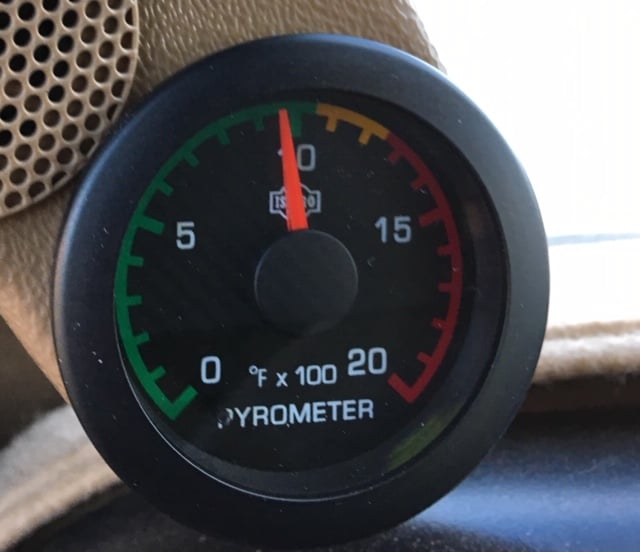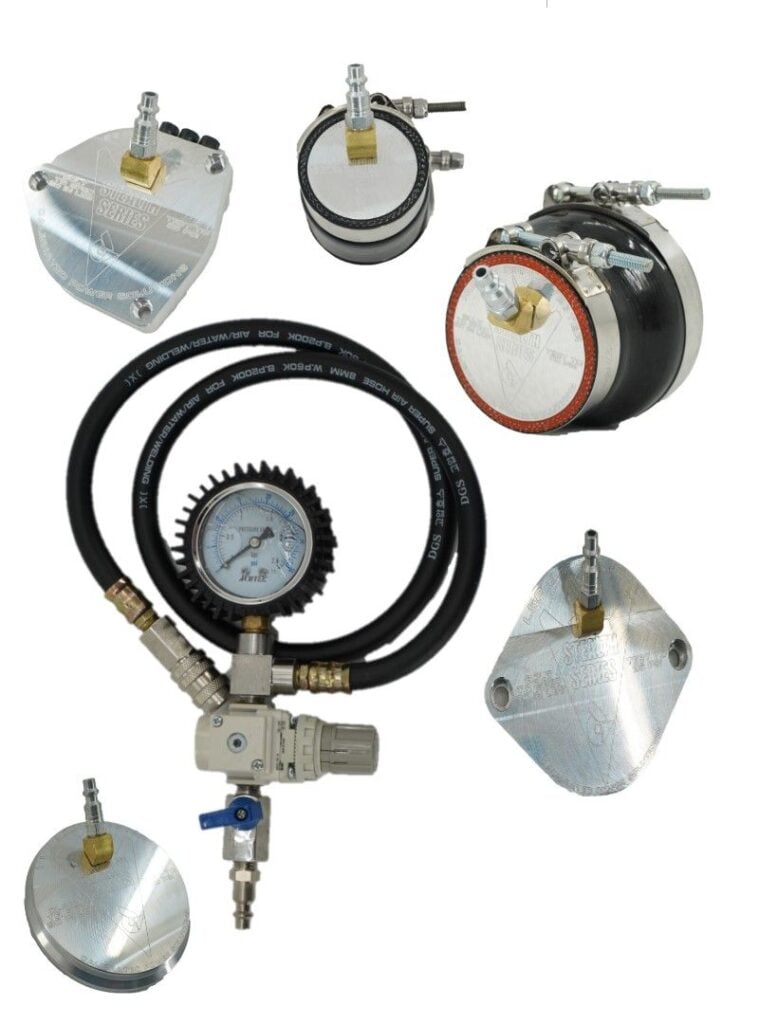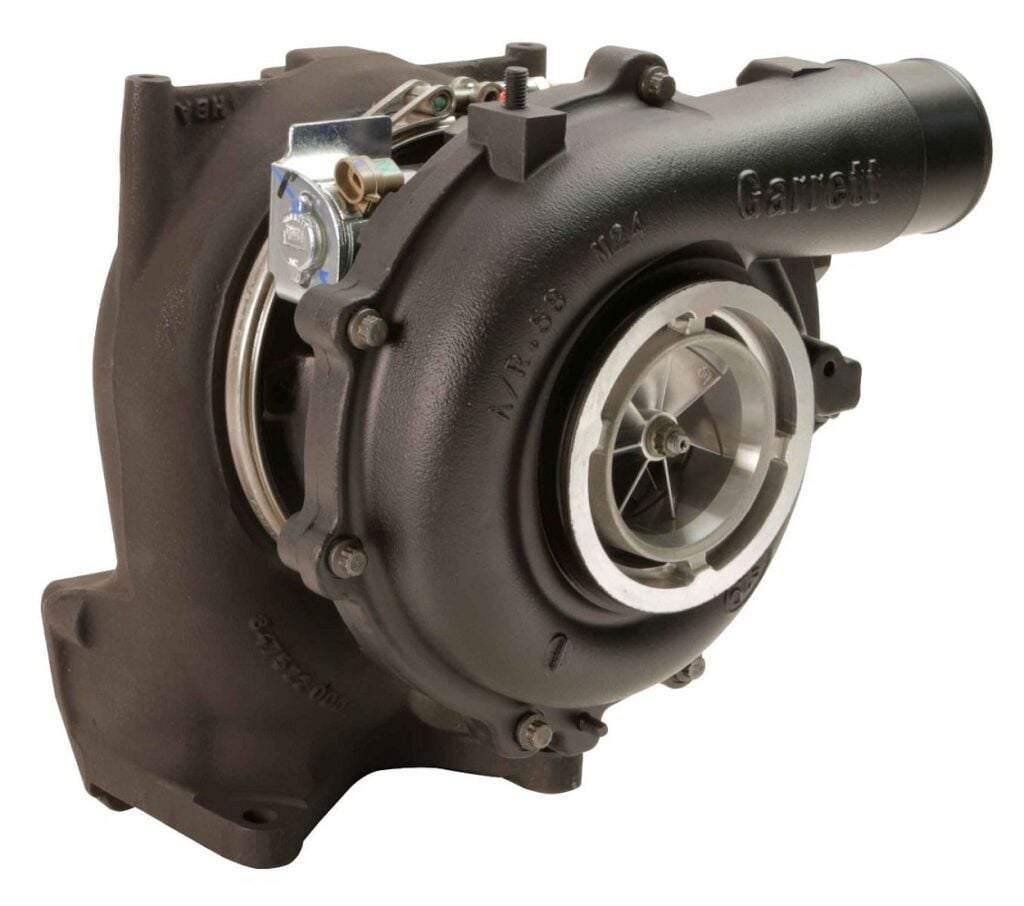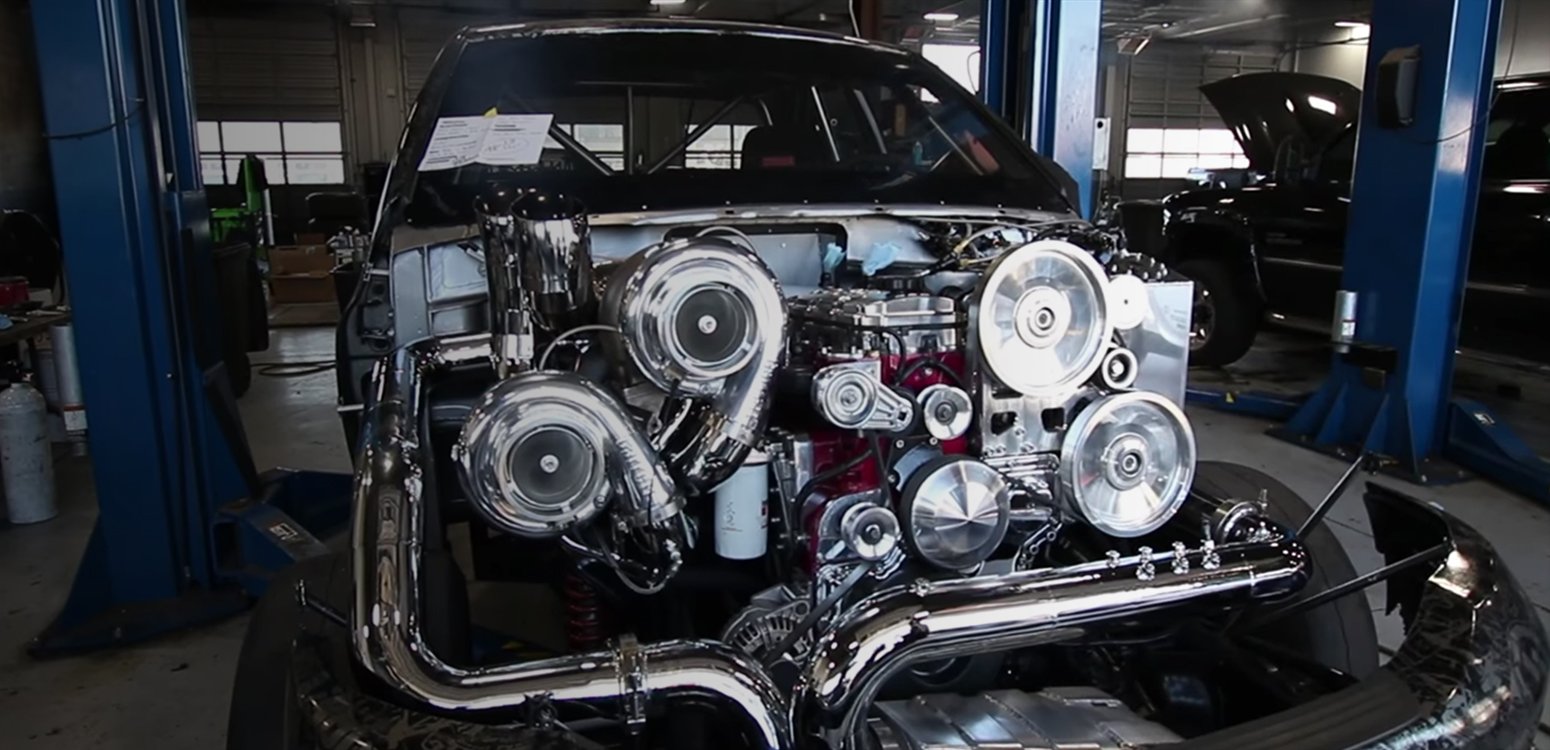Turbochargers are the single greatest invention humanity has ever produced. Forget about modern medicine, the pyramids in Egypt, space travel, or even artificial intelligence, turbochargers trump them all. They produce lots of boost with minimal drag on the engine, they don’t have any belts that will slip like a supercharger does, and they emit some of the coolest noises known to man. Because of these and so many more reasons, the turbocharger is the power adder of choice when it comes to diesel engines.
For a turbocharging system to work at its peak performance, all the air sucked in and compressed by the turbo needs to make it into the combustion chamber. This sounds simple, but there are a lot of parts that need to work correctly to ensure the massive volume and pressure of air moved by the turbocharger makes it to its final destination. The list of critical parts includes silicone couplers, boost tubes, the intercooler, an EGR valve, several metal gaskets, and T bolt clamps, and if just one of those components fail, you’ll have a boost leak.

When compressed air is allowed to escape from its normal pathway, the engine will ingest less air than was measured by the mass airflow sensor, which means your fueling will be incorrect. The engine will run richer than normal, which means the EGT’s are hotter than they should be, the truck will produce excess smoke, and your fuel mileage will suffer. Normally, a boost leak won’t cause a catastrophic engine meltdown right away, but if left untreated and the leak gets bad enough, it could cause some collateral damage. For example, if you have a gaping hole in an intercooler end tank and you bury your foot into the throttle, the turbo could experience an overspeed condition and damage a bearing, turbine wheel, or even the compressor wheel itself. So, we’ve established that boost leaks are bad, but the real question you should be asking yourself is how do I know if my truck has a boost leak? Luckily diagnosing and repairing the problem is simple, but you just need to know the warning signs, and know how to pinpoint the source of the leak.
The Symptoms
As with any mechanical problem, there will be symptoms that present themselves to give you a clue that something is wrong. In the case of a boost leak, your engine will be down on power, there will be extra smoke coming from the exhaust if you have a pre-emissions truck, more frequent regens if you have an emissions-equipped truck, higher than normal EGT, and lazy throttle response. Individually, those symptoms can mean a wide range of things, but luckily a boost leak is usually the first thing to rule out in the diagnostic process.
Tools and Gadgets Needed
One thing I always recommend for EVERY diesel truck is a good set of gauges or a way to monitor your engine’s operation. I don’t care if you have a 1995 12-valve Cummins or a 2022 Powerstroke, every diesel truck owner needs be able to keep their eye on at least two things: turbo boost pressure and exhaust gas temperature. If you have an older truck like a 12-valve Cummins or a 7.3 Powerstroke, an analog set of gauges from Isspro or Autometer would be a great addition to your interior. They are available in several styles and colors to suit your tastes, and tons of mounting pods are available to place them within the driver’s view. For the EGT gauge, you will have to drill into your exhaust manifold and tap some 1/8” NPT threads for the thermocouple to install, and you do want to place the sensor before the turbocharger if possible. Next up in order of importance is turbo boost, and usually this gauge will be a little easier to install. You will also have to drill and tap some threads, but the intake parts will be a little easier to get to, and they’re made from softer aluminum, which is easier to drill and tap. Typically, you want to monitor boost after the intercooler, right before the air enters the engine.

Newer diesel trucks make monitoring the engine’s vitals much easier since all the data you ever would want is already available on the OBD2 data stream. Products like the Edge Insight CTS3 or Banks iDash Super Gauge can display several parameters at the same time which makes for a more streamlined installation, and they can even flash warnings to alert the driver when certain values get too high or too low, plus they can read and clear DTC codes without the need to visit your local parts store to borrow the scan tool. On the iDash in my personal truck, I monitor turbo boost, EGT, current gear, trans temp, engine oil temp, coolant temp, and DPF soot load all on the same screen without having to install any extra sensors.
A gauge can tell you some of the story if you are chasing down a boost leak, but not the entire story. If you have a small tear in a silicone coupler or a pinhole leak in an intercooler end tank for example, you may only be losing 1-2 PSI in pressure which can be difficult to notice at a glance, but if you notice a combination of symptoms like EGT’s are slightly higher than normal, a bit of smoke, and perhaps a little less boost than usual, you can at least be pointed in the right direction, but the next step for diagnosing a boost leak does require you to pop the hood.
Tracking Down a Boost Leak
When trying to identify the source of missing boost pressure, the obvious first step would be to look for any couplers or boost tubes that have large tears or holes worn through. Sometimes you can spot the problem within seconds, but usually a boost leak will be difficult to spot with visual signs alone. More often than not, the leak will be small and will only let air through if there’s at least 5-6 PSI in the system, so we need some hardware to help with the diagnostics. Traditional automotive smoke machines aren’t super helpful detecting boost leaks because of the low pressure the machine produces, and how long it would take the smoke to travel through the entire system. Instead, one valuable tool you should own is the Calibrated Power Boost Leak Tester. This tool allows you to use an air compressor to pressurize the intake system with the engine off and listen for boost leaks. While most air compressors can reach 200 psi, that much force would surely damage your intake system or at least blow off a few couplers, so the Calibrated Power kit includes a regulator to lower the pressure to levels your engine would see in normal operation, in the 10 to 30 psi range. They offer adapter plates for most common engines, and once you have the tester installed and the regulator set, you simply look and listen for boost leaks. Because the engine is not running, the escaping air will produce a hissing sound you can easily hear, so you should be able to quickly track down the leak. If it’s a smaller leak that doesn’t make as much noise, simply spray some soapy water on possible leak areas until you find the telltale bubbles which will be a dead giveaway.

Common Boost Leak Areas
There are a dozen places pressurized air can escape from, but we’ll start with the most obvious. 9 times out of 10, a boost leak will be coming from a silicone coupler that either has a loose clamp or has a small hole worn through from years of use, cracks from dry rot, or from another part rubbing against the soft silicone. These are the easiest boost leaks to fix since you just have to tighten up the clamp or replace the boot in question. A smart move when replacing couplers is to step up to something a little stronger than stock, and Mishimoto has a complete line of DuraCore Silicone Couplers that are more durable, but also are more resistant to heat, pressure, and even fuel and oil. They come with constant tension T-bolt clamps for superior holding power, and they have a lifetime warranty.
One common area for leaks is the intercooler, and typical causes of damage are a minor collision or road debris, but even extreme off roading and frame flex can cause an end tank to crack and let air escape. In high-performance situations, an intercooler can burst from too much boost. Regardless of the cause, if the damage is on the end tank and it’s made from aluminum, it can usually be TIG welded for a permanent repair, or even JB welded in a pinch to get you home. If the end tanks are plastic (like the passenger side of an LMM Duramax or on both sides of the one-year-only ’05 Ram intercooler) unfortunately there is no great way to repair it, and the intercooler must be replaced.
The charge air cooler tubes are usually made from aluminum and connect the compressor discharge to the intercooler and the intercooler to the engine, and for the most part they are very durable, but if a clamp loosens up and the tube is allowed to move a little too close to some other metal part, it is possible to wear a hole in the aluminum tube and cause a boost leak. Just like with the intercooler, a “proper” repair means having somebody TIG weld the damaged area. A cold weld product like JB weld will also work in a pinch or if you can’t find someone to make the repair, or you can always go to a junk yard or the dealership to order a stock replacement.
One area which is prone to leaking air (although it is somewhat rare) is the within the turbocharger itself. The compressor cover is mounted to the center section of the turbo, and there is an O-ring seal that keeps air pressure from escaping. If this seal fails, replacements are available and usually it’s a straightforward job to make the repair, although on a Duramax or Powerstroke, it can be a bit tedious to access the turbo.
If you’ve ruled out all the obvious spots for a boost leak but still have air escaping, there are a few more places to check. There are many gasketed connections in the EGR system that must hold back pressurized air as well. Usually, these have a stainless-steel gasket and are bolted together between two flanges so usually they won’t leak, but if the truck has been recently serviced and any of the connections have been disturbed, there is a chance a gasket or mating surface has been damaged.
Opportunity for Upgrades
One of my favorite things about DIY maintenance and repair work is I can always spot an opportunity for an upgrade, and the money saved from not paying a shop to make the repair can be reinvested into your truck to make it perform better. Rather than installing OE replacement parts, why not upgrade to something that will help your engine run cooler, produce more horsepower, and become more efficient all at the same time? If you’re removing the intercooler tubes because one has worn through or cracked, why not step up to an AFE Bladerunner intercooler tube? They’re constructed from mandrel bent tubing, are powder coated wrinkle black for good looks and corrosion resistance, and of course, they’ll flow better than stock.

If you’re going through the effort to remove and replace the intercooler, why not install something that offers a performance improvement as well? A Banks Technicooler will bolt right in place of your stock intercooler, but it will have a higher efficiency core than stock which means it will remove more heat from the compressed air, while flowing more volume than stock. Another benefit to a Banks intercooler is important if you have a performance turbo setup, because the Technicooler can also withstand more pressure than stock.
If your compressor cover seal is leaking, replacement O-rings are available (and they’re very cheap), but for the sake of convincing your significant other, we could tell you that a boost leak at the compressor cover is justification for upgrading the turbocharger. A Fleece Cheetah, BD Screamer, or ATS Aurora turbo can flow more air than stock while producing less heat and will improve the overall power output of your engine.
Finally, if you find you need to replace the gaskets on a Cummins EGR valve or intake grid heater plate, there are some additional airflow upgrades worth a look, like a Banks Monster Ram Intake System. It will flow 122% more air volume than stock which of course means lower EGT, better MPG, and more horsepower, and the best part is it works with your stock EGR equipment, and it comes with new gaskets so you’ll gain performance at the same time as you stop your boost leaks.
Exhaust Leaks
Boost leaks occur on the “cold” side of a turbocharging system, but there are also leaks that can develop on the “hot” or exhaust side of a turbo setup that can cause similar problems. This could be a failed gasket between the cylinder head and the exhaust manifold, a crack in the exhaust manifold itself, a flex bellow in an up-pipe that has burst, or an up-pipe to turbo gasket that has failed. Sometimes if your truck has lived in a corrosive climate like the northeast, the hardware holding your exhaust components together can rust through or crack which will also cause a drive pressure leak. Drive pressure leaks usually will present similar symptoms as a boost leak, but they will also be an audible clue as well like a ticking sound consistent with engine RPM, or even a whistle. Because the sound you hear is exhaust gas escaping, usually there will be a small amount of soot leaving a witness mark which should help you narrow down where the leak is coming from.

Fix Those Leaks
Boost leaks aren’t the most interesting diagnosis you will make to your truck, but usually they can be some of the easiest repairs you’ll have to make. One last word of advice, try and identify the root cause of the problem in addition to the failure point itself, otherwise you could be making the same repair again in the future. For example, you might have a boost tube that’s too close to a moving part like a steering shaft, or your turbo produces more pressure than stock components were designed for. If you simply replace the failed part rather than identifying the reason it failed, you may find yourself making the same repair again in the near future.


06 Dodge Sprinter 2500 2.7 Litre,Low Boost,New Turbo